MCD Innovations: Made in the Shade
Upgrading an RV's Pleated Day-Night Shades and Visors
Article Date: May, 2009
Article and Photography by Mark Quasius
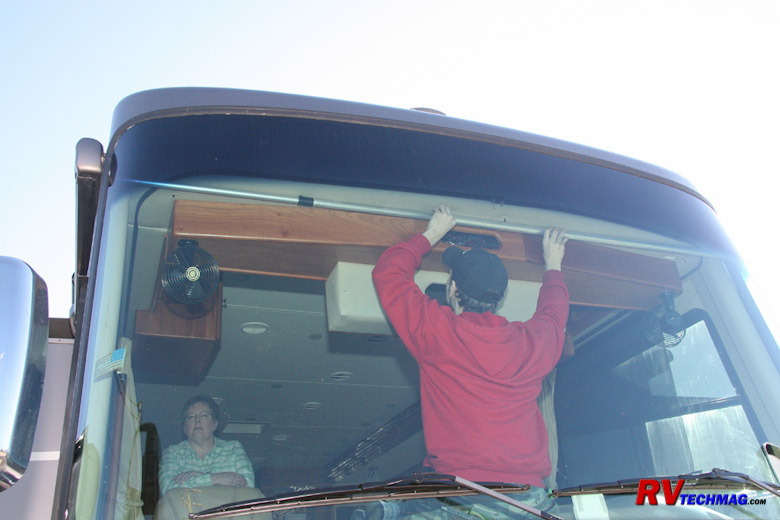
MCD Products
Every product that MCD produces is built to exacting tolerances and utilize high grade materials in their construction.
Shades are made at MCD's facility in McKinney, Texas and proudly dislay the Made in the USA logo.
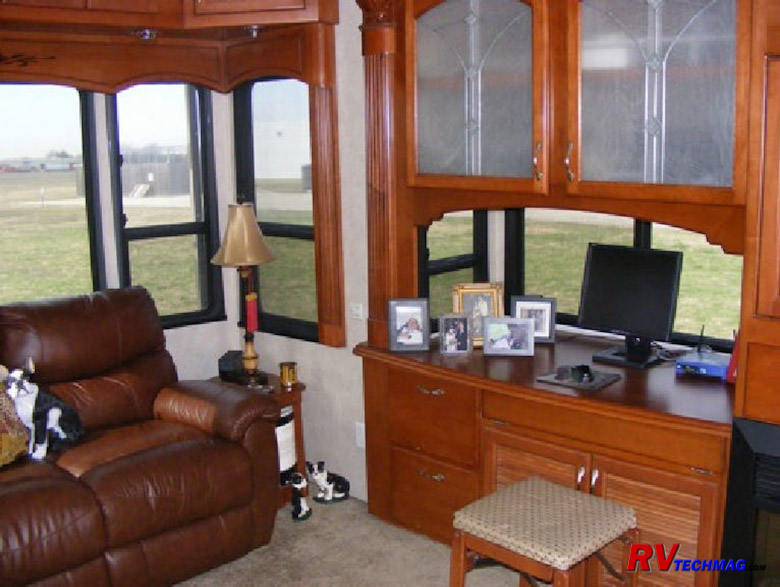
ClearView Sunscreen
Before we get too far into specific products, I'd better take some time out to talk about the proprietary solar screen
material that MCD uses in many of their products. I found that not all screen material is created the same. Many sunscreens are made with a
two-over-two weave, in that two vertical strands are laid together over two horizontal strands and then weaved in such a fashion. This type
of screen varies greatly in effectiveness. It relies more on blocking the light than filtering the heat. When this screen is viewed straight
on, it's much darker than MCD's ClearView screen. When you view this screen on an angle it gets even worse and it's extremely hard to see out
of the coach with this weave. This method gives the screen manufacturer an inexpensive way to make screen that offers some heat reduction. It
also allows them to use inexpensive fiberglass screen threads, pretty much like a bug screen on your windows at home. But this method is not
as effective at reducing heat intrusion and it seriously cuts down on the visibility through it, particularly when trying to view at an angle.
MCD's ClearView screen material is very high tech. When comparing it to competitor's screens think of it as comparing the
aluminum in a Boeing 747 to a soda can. There's that much difference. The MCD screens use a one-over-one weave and don't use inexpensive
fiberglass as the material. This design makes it easy to see out of the coach when the day shades are down. Viewing at an angle has minimal
effect and the view remains nice and clear. With this kind of view my initial impression was that it wasn't going to be doing a very good job
of filtering the heat out of the coach. But this system does a much greater job of filtering heat. I tend to think of it more as a thermal
barrier than a sunscreen. I've viewed competitive screens and the MCD screen under a magnifier and could see the difference in the construction.
The two-over weaves were chunky and rough coated while the MCD screen was crisp and clean. The two-over weave also has a tendency to pull during
the weave process. When holding screen panels up to the light you could see dark streaks where the threads had bunched together and lighter gaps
in between. Not that impressive to look at actually. But when viewing the MCD fabric it was clean and consistent throughout the entire screen panel
and it was easy to see out of while inside the coach. Interestingly enough it's virtually impossible to see into the coach during the daytime from
outside. If it's dark outside and you've lit up the interior of the coach this changes however, which is why the nighttime privacy shades are also
used. During normal daytime activities the daytime shades will act much like a one-way mirror.
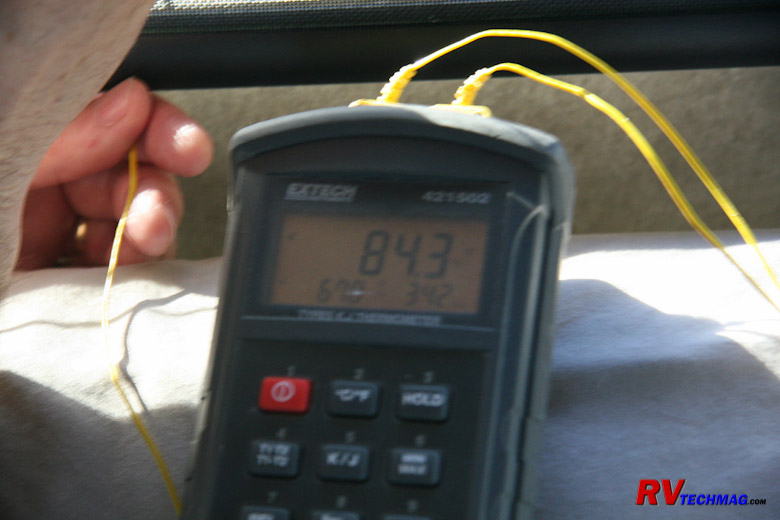
Temperature Readings On A Dual Pane Window
When performing some temperature readings one probe was placed between the screen and windshield while the other probe was
placed inboard of the screen. I was able to observe dual samples at the same time using this method. On a softly lit day with ambient temperatures
around 54 degrees Fahrenheit I observed roughly a 24 degree difference between the inside of the shade and the outside of the shade. This was on
the windshield. When similar tests were performed on a dual pane insulated side window the difference was 17.3 degrees. On a nice 90 degree, sunny
day the temperature readings between the windshield and screen are reported to be up to 50 degrees higher than the temps on the inside of the screen.
Further proof of my "Thermal Barrier" theory was made after the shades were installed and everything cooled down overnight.
The temperatures were down around freezing when we were there so my windshield got plenty cold overnight. When morning came I'd raise the sunscreen
shade and it felt like a freezer was just turned on. The sunscreen held back the cold air, just like it holds back the hot air on a warm, sunny day.
So, it's obvious that this high tech solar material has more going for it than just UV and sunlight filtering. I was very impressed.
Exterior Sunscreens
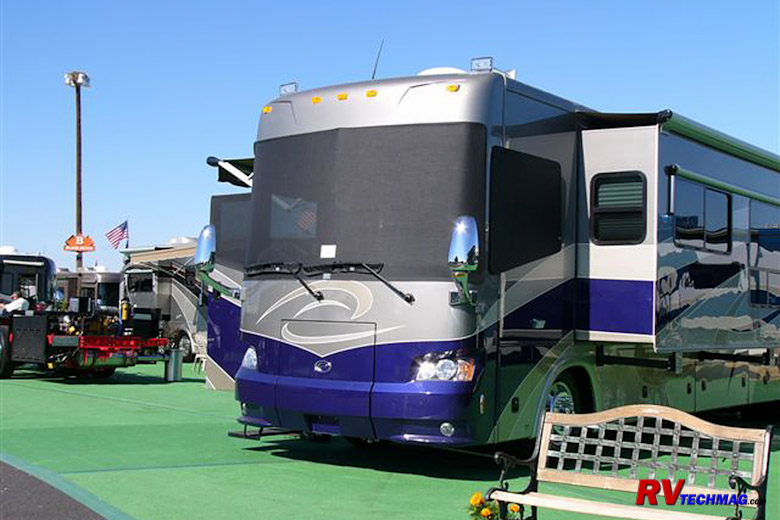
Exterior Sunscreens
This is the product that started it all. MCD Exterior Sunscreens used the same exclusive ClearView technology as the
Interior Sunscreens except they attached to the outside of the coach. With the advent of the American Duo interior roller shades, the demand
for exterior shades has gone down and this product has been discontinued.
It has been argued by some that you need to keep the shades on the outside of the RV to prevent heat from passing through
the glass and building up inside the coach. However, I've performed some tests with a dual probe digital thermometer that prove that the interior
solar shades are just as effective, while being super easy to deploy. Simply press a button to lower them or roll them back up. I can only conclude
that the exterior shades conduct heat to the windshield because they are resting on the surface of the glass while the interior roller screens have
the ability to reflect the heat back through the windshield. Indeed, the interior screen material was not overly hot to the touch so it must be
reflecting rather than absorbing the heat.
American Solo Shades

Nighttime Shade
The Solo shades are single roller shades, similar to window shades that you might find in your home. Except these are totally
different in that they are designed and built to MCD's critical specifications. These roller shades attach to a mounting rail via brackets. The
entire rail and roller assembly simply snaps into place into a series of mounting clips. These shades can be fitted with the ClearView sunscreen and
used as day shades or they can be fitted with 100% light blocking or room darkening privacy shades for nighttime use. A wide selection of shade
material is available so that you can choose the style and color that best matches the interior decor of your particular coach.
In addition, these shades can be manually operated or powered by electric motors. MCD's new Glide-Rise IV technology means
you just give a tug to the bottom of the manually operated shade and it effortlessly retracts onto the roller. There is one adjustment wheel on
the end of the rollers to control the rate of ascent while a second wheel on the opposite end sets the auto-stop position so that it doesn't
roll up too far. This is a real slick design and, if needed, can be easily adjusted, although once it's set it probably won't need any future
adjustments. The powered shades utilize MCD's compact 12 volt DC motor that resides inside the roller. No additional space is needed to locate
the motor. The motor is fed 12 volt power from a nearby location and can be remotely controlled via any number of controllers. You do not have
to run wires from a switch to each shade motor, just a common 12 volt feed. All switching is done remotely via the wireless controller(s).
American Duo Shades
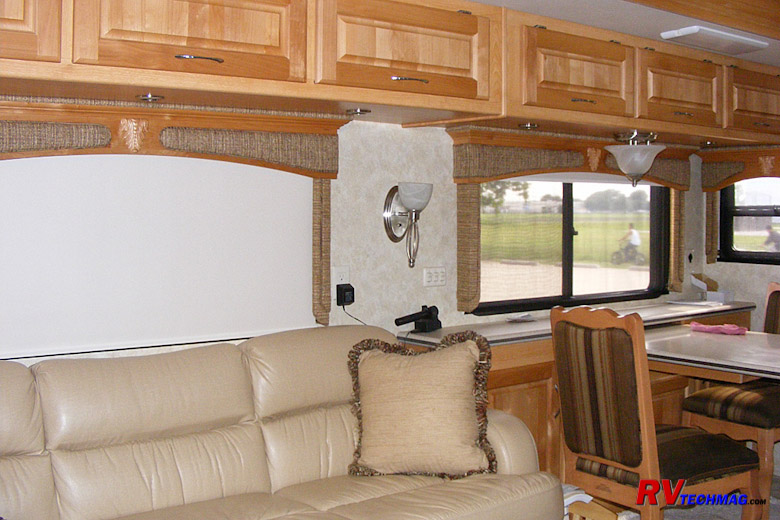
Nighttime Shade on Left - Daytime Shade on Right
The Duo shades are similar except that two rollers are mounted vertically above each other. This allows the use of one
roller with a daytime solar screen shade while the second roller is fitted with a nighttime privacy shade. The rollers can be manually operated
or fitted with 12 volt motors for power operation. A hybrid design can even be used whereby the day shades are manual and the nighttime shades
are powered. This was the system chosen for the main living area in my coach. The Duo design packs both rollers in a compact design so that it
fits into most existing window valances on motorhomes.
Powered Windshield Shades
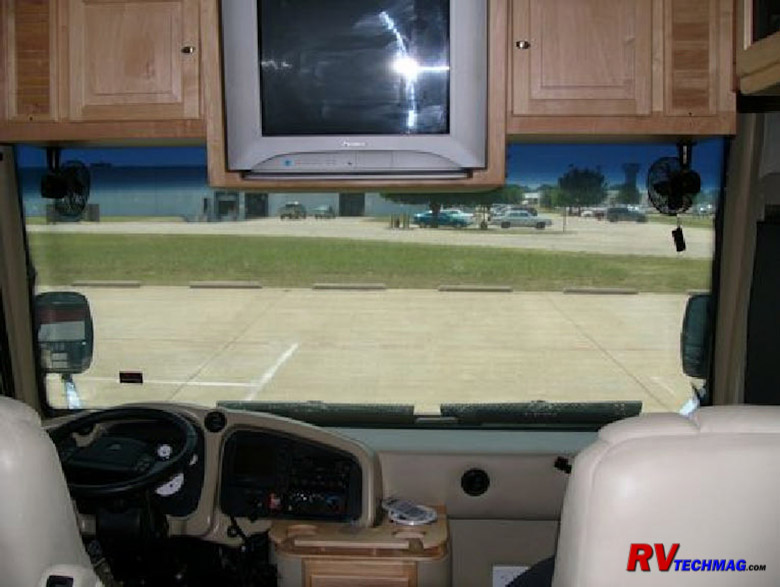
American Duo Windshield Shades
MCD's windshield shades can be either Solo or Duo. The biggest difference between the windshield shades and remote powered
shades is in the way they are controlled. Windshield shades utilize rocker switches rather than wireless remote controls. This is for safety reasons
as well as convenience. Most coaches already have a pair of basic powered sun shades so it makes sense to utilize the existing switches. In addition,
the windshield shades have top and bottom adjustable limit settings that are programmed into the motors. Each shade will have two lower limit settings.
One will be for when the ignition is off and another setting will be for when the ignition is on. This MCD developed safety feature prevents any
accidental lowering of the shades past a user set point. If a rocker switch would fail in the closed position this prevents the shade from blocking
the driver's view when driving. Competitive shades do not have this safety feature and is just another illustration of the kind of commitment that
MCD has towards their customers.
Velcro Attached Shades
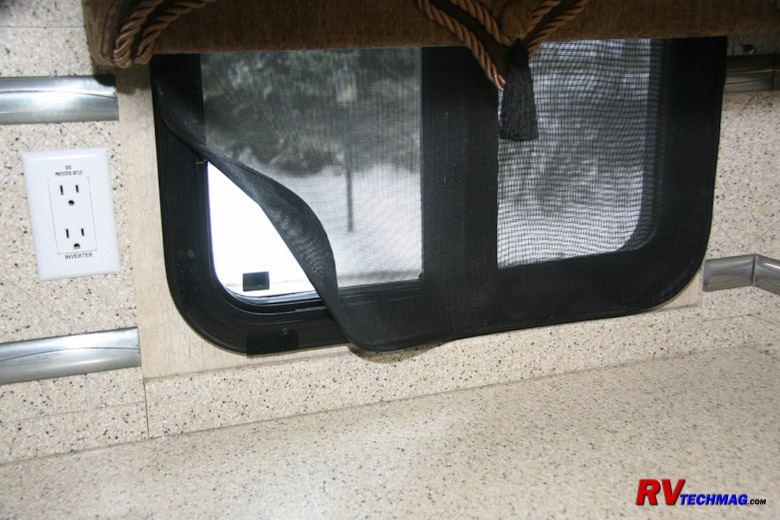
Velcro Attached Sunscreen
Sometimes it's just not practical to utilize a roller shade. Yet, the protection of a good sunscreen is desired. Maybe the
valances are too small to place two rollers into. Or, maybe the shade will be on there 95% of the time and won't need to be removed. In this case a
Velcro attached shade using MCD's ClearView technology is a good choice. I actually have them installed in three locations on my coach. Two were
for the above mentioned reasons while the third one was for the entry door. Having a hanging sunscreen dangling in front of the door means that
I'd have to power it up every time I wanted to use the door. By attaching a Velcro sunscreen to the screen door it opens whenever the door does
while still giving me excellent solar protection.
Sway Shades
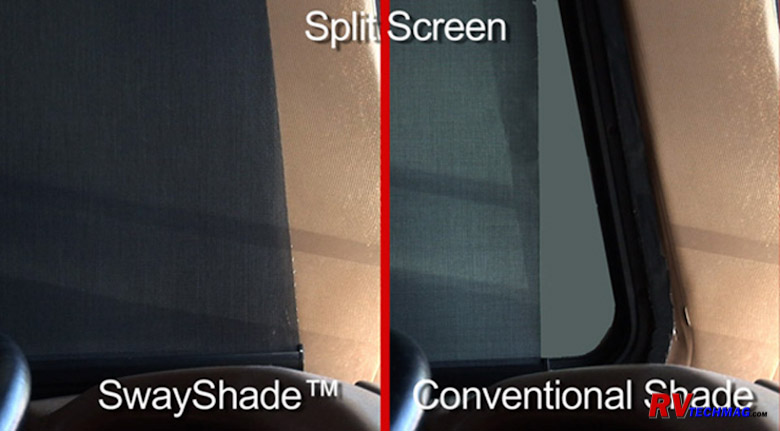
Sway Shade
Some cockpit side windows are not rectangular. They slope towards the front windshield. When a conventional roller shade
is extended a triangular gap remains where the shade does not cover. MCD's SwayShade uses a unique spiral mechanism that solves this by allowing
the shade to slide forward as it is extended. This eliminates light penetration and also provides for uncompromised privacy.
Remote Controllers
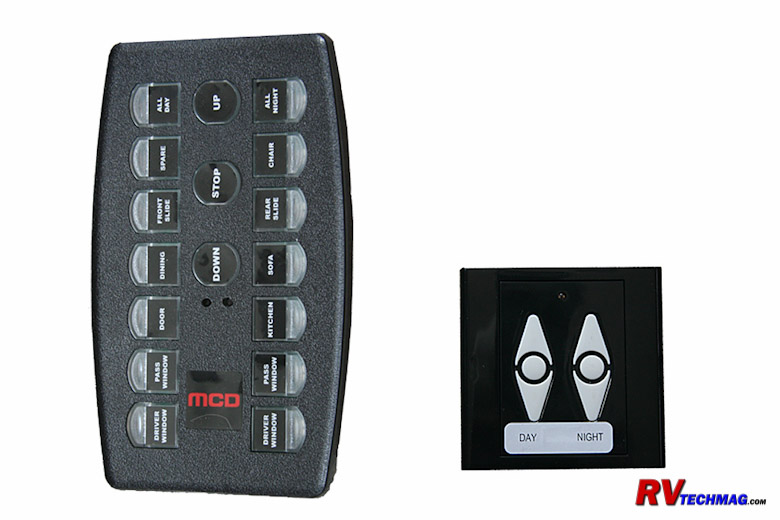
Remote Controllers
With the exception of the windshield shades, all powered MCD shades are operated by wireless remote controllers. Any one
shade can be married to any number of controllers. There are 2-channel controllers as well as 14-channel controllers. A 2-channel unit typically
controls one window with dual powered rollers. An example of this would be a cockpit side window. The 14-channel controller controls many shades.
Each button will be custom labeled for your coach. A single shade can be controlled from multiple controllers. For instance, a cockpit side
window can be controlled via a 2-channel remote mounted near the driver's seat. It can also be controlled via a 14-channel controller. In addition
it is possible to program any button on any controller to handle multiple shades. This means that that same cockpit window shade can be controlled
by an "all night shades" button or whatever else you can come up with. The remote controllers are wireless so they do not require any 12 volt
wiring. The 2-channel controllers use a CR-2032 watch style battery and the 14-channel controllers use a pair of AAA batteries. You can mount any
of the controllers on the wall or you can use them as hand held if you desire.
In the next section we'll follow the installation process of a set of MCD windshield shades.
Return to Home Page
If you enjoyed this article be sure to recommend RVtechMag.com to your friends, like us on Facebook or Twitter
or subscribe to our RSS feed.



|














